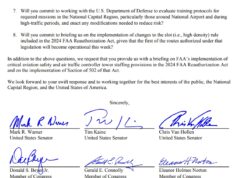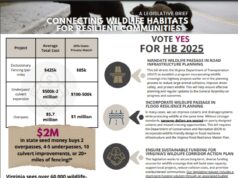A bit earlier this afternoon, several Northern Virginia Democrats – Senators Chap Petersen (Fairfax City, parts of Fairfax County), Jeremy McPike (parts of PW County, Manassas, Manassas Park) and Jennifer Wexton (parts of Loudoun and Fairfax Counties), Delegates John Bell (Sterling, Dulles, etc.) Jennifer Boysko (Herndon, Dulles, Chantilly), Wendy Gooditis (Leesburg, Ashburn, Middleburg, etc.) and Danica Roem (Manassas Park, Gainesville, etc.) – held a press conference (see video below) to demand that I-66 tolls (which Wexton called “highway robbery”) be suspended immediately, at least until issues they raised are addressed. What are those issues? Here’s a quick summary.
- Del. Bell said the tolls are “serious impacts for working families in my district.” Bell explained that he had attended the VDOT sessions which spelled out the plans to transform I-66, and “tolls were described as being a maximum of $17, and that’s for round trip.” Instead, we’ve seen tolls a lot higher than that for one way, let alone round trip.
- Del. Bell said the goal of 45 miles per hour has “now been lifted up to 55 [mph]” and that is “having a severe impact on raising the amount of tolls people are being charged.”
- Del. Bell said that the deal was one lane being added inside the Beltway, but that won’t happen for two years, and “charging people a toll without adding capacity…is a serious problem.” Later, Bell said he might not be satisfied with any I-66 tolls under any circumstances – “these are like extra taxes to get back and forth to work…need to go back to the drawing board.”
- Del. Boysko raised the issue of insufficient parking capacity, slug lines, etc., also the impact on working families who are struggling to get to work and the hybrid restrictions issue.
- Sen. Petersen said he has generally been an opponent of I-66 tolling, but that he changed his position in 2016 to support this project based on promises for increased capacity (e.g., a new lane inside the Beltway). According to Petersen, the tolling should not have started before the improvements are made. Petersen asserted, “you can’t start charging people for lanes that were previously free” (I don’t get that argument at all, given that solo drivers were using I-66 during rush hour illegally before).
- Sen. Wexton called the plan “highway robbery,” said her constituents have “very limited options” for west-east commutes. She added that the plan presented to the public, including promised improvements to I-66 and expanding HOV hours, is not the same thing as what we’re seeing now.
- Sen. McPike said they are calling for an “immediate halt” to the tolling “until these issues are resolved.” According to Sen. McPike, “the capacity was supposed to be in place” BEFORE tolling began.
- Nobody seemed to know why the tolling started now, as opposed to sometime in 2018. (my guess: Gov. McAuliffe wanted this to start before he left office, probably figuring this would be popular, which so far doesn’t seem to be the case!)
- Del.-elect Roem mentioned the hybrid issue, the limited options for commuters in her district other than driving, the need for “a lot more options” so people aren’t forced to pay these tolls. However, as she pointed out, the current “commuter culture” is “very dependent on driving,” and there’s not the “slugging culture” seen on I-95. She said this is a “quality of life issue.”
- What are the solutions to the I-66 corridor’s “traffic nightmare” if tolling isn’t? What I heard was increased bus service, increased lanes, increased commuter lots, etc.
- Sen. Petersen said that elected officials were briefed “ad nauseum” in 2016 by VDOT, but “nobody was talking about this type of scenario” regarding how high the peak tolls have been. Petersen added that they thought they had a deal with the governor, but that this “got out of sequence” has left us in the current situation, with the question being “what are we going to do going forward?”
My view is that adding more asphalt is almost certainly not the answer, that what we need is a focus on smart growth/transit-oriented development, a dedicated funding stream for Metro that allows major improvements in commuter rail and bus, telecommuting and other options including bicycle lanes. But the bottom line is that we’re not going to fix a sprawl pattern of development overnight, if ever, as the model is inherently problematic (e.g., it was built at a time of cheap, seemingly limitless fossil fuels and minimal environmental concerns compared to today).
As for the complaints about solo drivers, who previously were using the I-66 HOV lanes illegally during rush hour, now having the OPTION to use them if they pay a toll, I don’t really get the problem there. Again, those folks were using the lanes illegally before, so now they have a new, legal option they didn’t have before. With regard to the tolls being too high, the problem is that if tolls are capped, they might not be high enough to keep traffic flowing, in which case it could be a “worst of all worlds” situation, in which people have to pay significant tolls but STILL are sitting in bumper-to-bumper traffic, not moving and sucking in exhaust fumes.
By the way, I wonder what Gov. McAuliffe – who touted this plan many times, very loudly and publicly – is thinking right about now, with just a few weeks left in his term. I mean, if this thing goes down the tubes, that seems like it would be a major black eye for McAuliffe as he heads out the door…possibly en route to a run for president in 2020.





![Rep. Don Beyer (D-VA08) on “reports of the devastating effects Donald Trump’s Project 2025 agenda would have on [Metro]”](https://bluevirginia.us/wp-content/uploads/2024/10/trumpmetro-238x178.jpg)





![Saturday News: “Trump’s latest tariff TACO probably won’t make your life more affordable”; “The Epstein Email Cache: 2,300 Messages, Many of Which Mention Trump”; “[MTG] questions if Trump is still the ‘America First’ president”; “Jim Ryan tells all: ‘What did the Governor know, when did he know it?’”](https://bluevirginia.us/wp-content/uploads/2025/11/montage1115-100x75.jpg)

